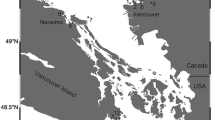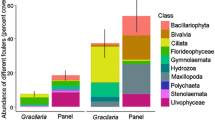Abstract
This paper describes a novel sediment bioassay which can be used in intertidal mud or sand, thereby exposing a contaminated sediment to a large range of naturally colonising fauna. Natural sediment, in which invertebrates had been killed by freezing, was mixed with diesel-based drilling mud (nominally 1000 mg kg−1 dry wt as diesel-based-mud equivalents) or particulate tributyltin (TBT) copolymer antifouling paint (nominally 0.1, 1.0 and 10 mg TBT kg−1 dry wt). The contaminated sediments were then re-laid intertidally in trenches lined with polythene mesh.
All treatments except 0.1 mg TBT kg−1 impaired the casting activity of the polychaete, Arenicola marina. Populations of the polychaete, Scoloplos armiger, and the amphipod, Urothoe poseidonis, were reduced in all contaminated treatments, and a dose-response effect of TBT was demonstrated. No clear effects on other groups (e.g. molluscs) were seen.
The results showed that this is a useful technique, although further development is required before it can be used routinely.
Similar content being viewed by others
References
Alden, R. W., A. J. Butt & R. J. Young, 1988. Toxicity testing of sublethal effects of dredged materials. Arch. Envir. Contam. Toxicol. 17: 381–389.
Arnoux, A., G. Stora & C. Diana, 1985. In situ experimental study of the evolution and recolonisation of polluted sediments. Mar. Pollut. Bull. 16: 313–318.
Bilyard, G. R., 1987. The value of benthic infauna in marine pollution monitoring studies. Mar. Pollut. Bull. 18: 581–585.
Blackman, R. A. A., T. W. Fileman, R. J. Law & J. E. Thain, 1988a. The effects of oil-based drill-muds in sediments on the settlement and development of biota in a 200-day tank test. Oil. Chem. Pollut. 4: 1–19.
Blackman, R. A. A., R. J. Law & J. E. Thain, 1988b. The effects of new oil-based drill-muds in sediments on the settlement and development of biota in an improved tank test. Oil. Chem. Pollut. (in press).
Boesch, D. F., E. M. Burreson, L. C. Shaffner, H. I. Kator, C. L. Smith, D. M. Alongi, M. A. Bowen & P. O. DeFur, 1981. Experimental Colonization of Crude Oil Contaminated Sediment by Benthos on the Middle Atlantic Continental Shelf. USDI Bureau of Land Management Final Report No. BLM/YL/SR-81/01. Virginia Institute of Marine Science, Gloucester Point, 258 pp.
Decker, C. J. & J. W. Fleeger, 1984. The effect of crude oil on the colonization of meiofauna into salt marsh sediments. Hydrobiologia 118: 49–58.
Fauchald, K & P. A. Jumars, 1979. The diet of worms. Oceanogr. Mar. Biol. Ann. Rev. 17: 193–284.
Friesen, M. K., T. D. Galloway & J. F. Flannagan, 1983. Toxicity of the insecticide permethrin in water and sediment to nymphs of the burrowing mayfly Hexagenia rigida (Ephemeroptera; Ephemeridae). Can. Ent. 115: 1007–1014.
Keilty, T. J., D. S. White & P. F. Landrum, 1988. Short-term lethality and sediment avoidance assays with endrincontaminated sediment and two oligochaetes from Lake Michigan. Arch. Envir. Contam. Toxicol. 17: 95–101.
Long, E. R. & P. M. Chapman, 1985. A sediment quality triad: measures of sediment contamination, toxicity, and infaunal community composition in Puget Sound. Mar. Pollut. Bull. 16: 405–415.
McLeese, D. W., L. E. Burridge & J. van Dinter, 1982. Toxicities of five organochlorine compounds in water and sediment to Nereis virens. Bull. Envir. Contam. Toxicol. 28: 216–220.
Nicolaisen, W. & E. Kanneworff, 1969. On the burrowing and feeding habits of the amphipods Bathyporeia pilosa Lindström and Bathyporeia sarsi (Walker). Ophelia 6: 231–250.
Salazar, M. H. & S. M. Salazar, 1985. Ecological Evaluation of Organotin-Contaminated Sediment. Naval Ocean Systems Center, San Diego, Tech. Rep. no. 1050, 22 pp.
Savidge, W. B. & G. L. Taghon, 1988. Passive and active components of colonization following two types of disturbance on intertidal sandflat. J. Exp. Mar. Biol. Ecol. 115: 137–155.
Swartz, R. C., 1987. Toxicological methods for determining the effects of contaminated sediment on marine organisms. In K. L. Dickson, A. W. Maki & W. A. Brungs (eds). Fate and Effects of Sediment-Bound Chemicals in Aquatic Systems. Pergamon Press, New York: 183–198.
Tagatz, M. E. & C. H. Deans, 1983. Comparison of field- and laboratory-developed estuarine benthic communities for toxicant exposure studies. Wat. Air Soil Pollut. 20: 199–209.
Tagatz, M. E., R. S. Stanley, G. R. Plaia & C. H. Deans, 1987. Responses of estuarine macrofauna colonising sediments contaminated with fenvalerate. Envir. Toxicol. Chem. 6: 21–25.
Thrush, S. F. & D. S. Roper, 1988. Merits of macrofaunal colonization of intertidal mudflats for pollution monitoring: preliminary study. J. Exp. Mar. Biol. Ecol. 116: 219–233.
Waldock, M. J., J. E. Thain & M. E. Waite, 1987. The distribution and potential toxic effects of TBT in UK estuaries during 1986. Appl. Organometal. Chem. 1: 287–301.
Author information
Authors and Affiliations
Rights and permissions
About this article
Cite this article
Matthiessen, P., Thain, J.E. A method for studying the impact of polluted marine sediments on intertidal colonising organisms; tests with diesel-based drilling mud and tributyltin antifouling paint. Hydrobiologia 188, 477–485 (1989). https://doi.org/10.1007/BF00027815
Issue Date:
DOI: https://doi.org/10.1007/BF00027815




